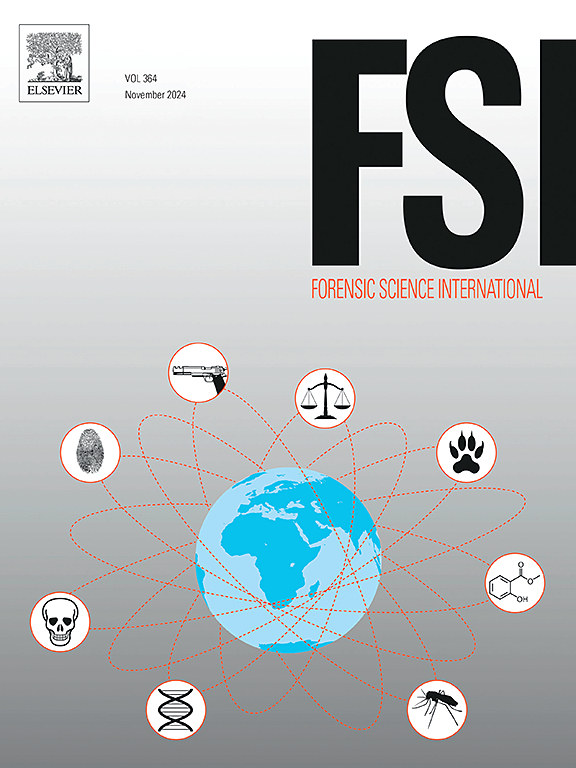用轮廓分析法定量评价锯切地板的形状模式
IF 2.5
3区 医学
Q1 MEDICINE, LEGAL
引用次数: 0
摘要
在肢解案件中,法医人类学家评估骨头切割表面并估计锯类特征,这有助于调查和法律诉讼。以前的出版物表明,锯类特征,如齿形、锯组和功率,可以从切刀轮廓的形状和大小推断出来。然而,这些研究是基于主观的视觉分类,有时统计评估有限。本研究使用椭圆傅立叶分析来定量评估切口形状和锯类特征之间的关系。用19把锯在解剖学上有天赋的浸渍过的人的四肢(n = 19)上做出不完整的切口轮廓(n = 133)进行了评估。刻痕剖面捕获与立体显微镜和封闭的轮廓被创建,并受到椭圆傅里叶和主成分分析。对所得到的主成分进行了permanova和Kruskal-Wallis分析,以评估锯组、功率和齿形对切口形状的影响。采用交叉验证逐步判别函数分析(DFA)评估分类精度。进出口形态差异无统计学意义(p = 0.31)。所有锯类特征都得到了显著的结果。DFA对齿形的分类准确率为88.0 %。扁平和u形切口与纵锯有关,而w形切口表明是横切锯。DFA对锯功率的分类准确率为89.5 %。平均而言,机械锯产生的切口宽度比手锯大。然而,切缝地板形态与锯集之间的关系更为复杂。这些对切口形状的定量分析通常支持文献中建立的轶事关系及其在法医评估中的效用。本文章由计算机程序翻译,如有差异,请以英文原文为准。
A quantitative assessment of Saw Kerf floor shape patterns using outline analysis
In dismemberment cases, forensic anthropologists evaluate bony cut surfaces and estimate saw class characteristics, which can aid in investigative and legal proceedings. Previous publications indicate that saw class characteristics, such as tooth shape, saw set, and power, can be deduced from the kerf profile shape and size. However, these studies are based on subjective visual categorizations, at times with limited statistical assessments. This study used elliptical Fourier analysis to quantitatively assess relationships between kerf shapes and saw class characteristics. Incomplete kerf profiles (n = 133) made with 19 saws in anatomically gifted, macerated human limbs (n = 19) were assessed. Kerf profiles were captured with a stereomicroscope and closed outlines were created and subjected to elliptical Fourier and principal component analyses. PerMANOVAs and Kruskal-Wallis analyses were performed on the resultant principal components to assess the effects of saw set, power, and tooth shape on kerf shape. Cross-validated stepwise discriminant function analyses (DFA) were performed to evaluate classification accuracy. There was no significant difference in entrance and exit morphology (p = 0.31). Significant results were obtained for all saw class characteristics. DFA classified tooth shape with 88.0 % accuracy. Flat and U-shaped kerfs were associated with rip saws while W-shaped kerfs were indicative of crosscut saws. DFA classified saw power with 89.5 % accuracy. On average, mechanical saws produced kerfs with larger widths compared to hand saws. Relationships between kerf floor morphology and saw set, however, were more complex. These quantitative analyses of kerf shape generally support anecdotal relationships established in the literature and its utility in forensic assessment.
求助全文
通过发布文献求助,成功后即可免费获取论文全文。
去求助
来源期刊

Forensic science international
医学-医学:法
CiteScore
5.00
自引率
9.10%
发文量
285
审稿时长
49 days
期刊介绍:
Forensic Science International is the flagship journal in the prestigious Forensic Science International family, publishing the most innovative, cutting-edge, and influential contributions across the forensic sciences. Fields include: forensic pathology and histochemistry, chemistry, biochemistry and toxicology, biology, serology, odontology, psychiatry, anthropology, digital forensics, the physical sciences, firearms, and document examination, as well as investigations of value to public health in its broadest sense, and the important marginal area where science and medicine interact with the law.
The journal publishes:
Case Reports
Commentaries
Letters to the Editor
Original Research Papers (Regular Papers)
Rapid Communications
Review Articles
Technical Notes.
 求助内容:
求助内容: 应助结果提醒方式:
应助结果提醒方式:


